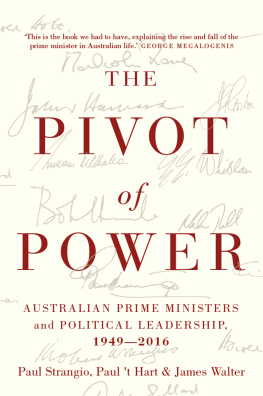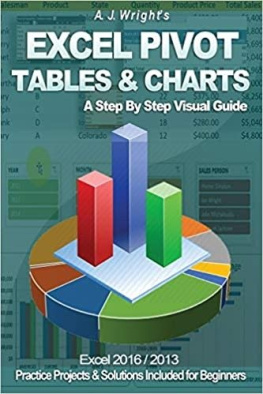This is number one hundred and seventy-five in the
second numbered series of the
Miegunyah Volumes
made possible by the
Miegunyah Fund
established by bequests
under the wills of
Sir Russell and Lady Grimwade.
Miegunyah was the home of
Mab and Russell Grimwade
from 1911 to 1955.
Paul Strangio is Associate Professor of Politics in the School of Social Sciences at Monash University. A political historian and biographer, he has written extensively about political leadership and political parties in Australia. Before recent studies of the Australian prime ministers, his last book was Neither Power Nor Glory: 100 Years of Political Labor in Victoria, 18561956 (2012). Paul has also been a long-time commentator on Australian politics in the print and electronic media.
Paul 't Hart is Professor of Public Administration, Utrecht School of Governance, Utrecht University, the Netherlands. A former professor of political science at the Australian National University, since 2007 Paul has been a core faculty member of the Australia and New Zealand School of Government. He writes about political and public service leadership, crisis management, policy evaluation and public accountability. His latest book is The Leadership Capital Index: A New Perspective on Political Leadership (2017).
James Walter is Professor of Politics in the School of Social Sciences at Monash University and a Fellow of the Academy of Social Sciences in Australia. He has published widely on biography, political psychology, leadership, political thought and policy deliberation. His last book, before recent studies of the Australian prime ministers, was What Were They Thinking? The Politics of Ideas in Australia (2010).
Prior to the present volume, the authors jointly published Understanding Prime-Ministerial Performance: Comparative Perspectives (2013), and Settling the Office: The Australian Prime Ministership from Federation to Reconstruction (2016).
THE
PIVOT
of
POWER
AUSTRALIAN PRIME MINISTERS
and POLITICAL LEADERSHIP,
19492016
Paul Strangio, Paul 't Hart & James Walter
THE MIEGUNYAH PRESS
An imprint of Melbourne University Publishing Limited
Level 1, 715 Swanston Street, Carlton, Victoria 3053, Australia
www.mup.com.au
First published 2017
Text Paul Strangio, Paul 't Hart and James Walter, 2017
Design and typography Melbourne University Publishing Limited, 2017
This book is copyright. Apart from any use permitted under the Copyright Act 1968 and subsequent amendments, no part may be reproduced, stored in a retrieval system or transmitted by any means or process whatsoever without the prior written permission of the publishers.
Every attempt has been made to locate the copyright holders for material quoted in this book. Any person or organisation that may have been overlooked or misattributed may contact the publisher.
Endpapers: Front, Department of Works & Railways Provisional Parliament House Canberra Main Floor Plan (1924); Back, Parliament House Construction Authority, 1990.
Cover design by Design by Committee
Typeset in 11/15pt Minion by Cannon Typesetting
Printed in China by 1010 Printing International Ltd
National Library of Australia Cataloguing-in-Publication entry
Pivot of power/by Paul Strangio, Paul 't Hart, James Walter.
9780522868746 (hardback)
9780522868753 (ebook)
Includes index.
Prime ministersAustraliaHistory.
PoliticiansAustraliaHistory.
AustraliaPolitics and governmentHistory.
Other Creators/Contributors:
Hart, Paul 't, author.
Walter, James, 1949 author.
Prime Ministers of Australia:
1949 2016
| Prime Minister | Period of Office |
| Robert Menzies | 19 December 1949 26 January 1966 |
| Harold Holt | 26 January 1966 19 December 1967 |
| John McEwen | 19 December 1967 10 January 1968 |
| John Gorton | 10 January 1968 10 March 1971 |
| William (Billy) McMahon | 10 March 1971 5 December 1972 |
| Gough Whitlam | 5 December 1972 11 November 1975 |
| Malcolm Fraser | 11 November 1975 11 March 1983 |
| Bob Hawke | 11 March 1983 20 December 1991 |
| Paul Keating | 20 December 1991 11 March 1996 |
| John Howard | 11 March 1996 3 December 2007 |
| Kevin Rudd | 3 December 2007 24 June 2010 |
| 27 June 2013 18 September 2013 |
| Julia Gillard | 24 June 2010 27 June 2013 |
| Tony Abbott | 18 September 2013 15 September 2015 |
| Malcolm Turnbull | 15 September 2015 |
Introduction
F OLLOWING HER FALL from power in 2013, Australias first female prime minister, Julia Gillard, was asked whether in retrospect she thought she had been ready for the position upon ascending to it three years earlier. Gillard retorted: I think I was as ready as you can be. You dont get a bloody manual for it. It is true that upon assuming the highest political office in the land, new occupants receive no instruction book to guide them on their journey. Nor are prime ministers the beneficiaries of an equivalent to the ritual in the United States where departing presidents leave handwritten notes in the Oval Office for their successors, offering them words of advice and encouragement.
What they do inherit is a repertoire of practices and expectations, gained by observing their immediate predecessors during their own ascent to power. There is in addition the infrastructure of office: hard-won resources developed by successive incumbents. Few attend closely to the history from which the repertoire they take for granted, or the resources at their command, has emerged. Yet what one English scholar has written about the British prime ministership similarly applies to its Australian counterpart: the job is a product of history. History deals and it is this on which our investigation is focused.
In the first volume of this study of the Australian prime ministership, we charted the offices development from its prehistory in the self-governing colonies of the second half of the nineteenth century and through the first fifty years of the Commonwealth to the defeat of Ben Chifleys Labor government in 1949. The architects of the Commonwealth constitution anticipated that the office would enjoy pre-eminent status in a federated Australiaone prophesised that it would be the blue ribbon of the highest possible ambition. Their own experience of parliamentary politics in the colonies, where executives were constrained by legislatures in conditions in which party systems had not yet consolidated and governments were frequently transient, had not filled them with anxiety about a powerful executive. As a necessary concession to achieving Federation, however, they designed a constitution that confined the authority of the Commonwealth to ensure that in the newly created nation the rights of the statesparticularly the smaller oneswould not be subjugated.











